Shoreline Change around a River Delta on the Cox’s Bazar Coast of Bangladesh
Abstract
1. Introduction
1.1. Aim of the Study
- detection of the shoreline position using Landsat images for the period 1972–2016 to understand the morphological behavior of the southeast coast of Bangladesh, focusing on the Reju River mouth delta area;
- identification of the causes of the recent erosion problem north of the Reju River delta using a numerical model.
1.2. Previous Studies
2. Study Area
3. Data
3.1. Shoreline Data
3.2. Wave and Rainfall Data
4. Morphological Analysis
4.1. Shoreline and Image Interpretation
4.2. Variation in the Area of the Delta
4.2.1. Influence of the River Mouth Position on the Delta
4.2.2. Influence of Rainfall on the Delta
4.2.3. Influence of Offshore Waves on the Delta
4.3. Variation in the Amplitude of the Sand Spit
5. Numerical Computation
5.1. Model Description
5.2. Model Setup
5.3. Model Results
6. Discussion
7. Conclusions
Author Contributions
Funding
Acknowledgments
Conflicts of Interest
References
- Wright, L.D.; Coleman, J.M. Variations in morphology of major river deltas as functions on ocean wave and river discharge regimes. Am. Assoc. Pet. Geol. Bull. 1973, 57, 370–398. [Google Scholar]
- Nienhuis, J.H.; Ashton, A.D.; Roos, P.C.; Hulscher, S.J.; Giosan, L. Wave reworking of abandoned deltas. Geophys. Res. Lett. 2013, 40, 5899–5903. [Google Scholar] [CrossRef]
- Ford, M. Shoreline changes interpreted from multi-temporal aerial photographs and high resolution satellite images: Wotje atoll, Marshall Islands. Remote Sens. Environ. 2013, 135, 130–140. [Google Scholar] [CrossRef]
- Bruno, M.F.; Molfetta, M.G.; Mossa, M.; Nutricato, R.; Morea, A.; Chiaradia, M.T. Coastal observation through Cosmo-SkyMed high-resolution SAR images. In Proceedings of the 14th International Coastal Symposium, Sydney, Australia, 6–11 March 2016. [Google Scholar]
- Valentini, N.; Saponieri, A.; Molfetta, M.G.; Damiani, L. New algorithms for shoreline monitoring from coastal video systems. Earth Sci. Inform. 2017, 10, 495–506. [Google Scholar] [CrossRef]
- Harley, M.D.; Turner, I.L.; Short, A.D.; Ranasinghe, R. Assessment and integration of conventional, RTK-GPS and image-derived beach survey methods for daily to decadal coastal monitoring. Coast. Eng. 2011, 58, 194–205. [Google Scholar] [CrossRef]
- El-Asmar, H.M.; Hereher, M.E. Change detection of the coastal zone east of the Nile Delta using remote sensing. Environ. Earth Sci. 2010, 62, 769–777. [Google Scholar] [CrossRef]
- Chu, Z.X.; Sun, X.G.; Zhai, S.K.; Xu, K.H. Changing pattern of accretion/erosion of the modern Yellow River (Huanghe) subaerial delta, China: Based on remote sensing images. Mar. Geol. 2006, 227, 13–30. [Google Scholar] [CrossRef]
- Dan, S.; Stive, M.J.; Walstra, D.J.; Panin, N. Wave climate, coastal sediment budget and shoreline changes for the Danube Delta. Mar. Geol. 2009, 262, 39–49. [Google Scholar] [CrossRef]
- Jiménez, J.A.; Sánchez-Arcilla, A. A long-term (decadal scale) evolution model for microtidal barrier systems. Coast. Eng. 2004, 51, 749–764. [Google Scholar] [CrossRef]
- Kraus, N.C. Analytical Model of Spit Evolution at Inlets. In Proceedings of the Coastal Sediments 1999, New York, NY, USA, 21–23 June 1999; pp. 1739–1754. [Google Scholar]
- Bergillos, R.J.; López-Ruiz, A.; Ortega-Sánchez, M.; Masselink, G.; Losada, M.A. Implications of delta retreat on wave propagation and longshore sediment transport—Guadalfeo case study (southern Spain). J. Mar. Geol. 2016, 382, 1–16. [Google Scholar] [CrossRef]
- Bergillos, R.J.; Rodríguez-Delgado, C.; Ortega-Sánchez, M. Advances in management tools for modeling artificial nourishments in mixed beaches. J. Mar. Syst. 2017, 172, 1–13. [Google Scholar] [CrossRef]
- Bergillos, R.J.; Masselink, G.; Ortega-Sánchez, M. Coupling cross-shore and longshore sediment transport to model storm response along a mixed sand-gravel coast under varying wave directions. Coast. Eng. 2017, 129, 93–104. [Google Scholar] [CrossRef]
- Petersen, D.; Deigaard, R.; Fredsøe, J. Modelling the morphology of sandy spits. Coast. Eng. 2008, 55, 671–684. [Google Scholar] [CrossRef]
- Thomas, T.; Lynch, S.K.; Phillips, M.R.; Williams, A.T. Long-term evolution of a sand spit, physical forcing and links to coastal flooding. Appl. Geogr. 2014, 53, 187–201. [Google Scholar] [CrossRef]
- Nienhuis, J.H.; Ashton, A.D.; Nardin, W.; Fagherazzi, S.; Giosan, L. Alongshore sediment bypassing as a control on river mouth morphodynamics. J. Geophys. Res. Earth Surf. 2016, 121, 664–683. [Google Scholar] [CrossRef]
- Ahmed, B. Landslide Susceptibility Modelling Applying User-Defined Weighting and Data-Driven Statistical Techniques in Cox’s Bazar Municipality, Bangladesh. Nat. Hazards 2015, 79, 1707–1737. [Google Scholar] [CrossRef]
- Hassan, M.M.; Shahnewaz, M. Measuring tourist service satisfaction at destination: A case study of Cox’s Bazar sea beach, Bangladesh. Am. J. Tour. Manag. 2014, 3, 32–43. [Google Scholar]
- Rahman, H.; Khan, Y.A. Landslides and stability of coastal cliffs of Cox’s Bazar area, Bangladesh. Nat. Hazards 1995, 12, 101–118. [Google Scholar] [CrossRef]
- Bari, S.H.; Rahman, M.T.; Hoque, M.A.; Hussain, M.M. Analysis of seasonal and annual rainfall trends in the northern region of Bangladesh. Atmos. Res. 2016, 176, 148–158. [Google Scholar] [CrossRef]
- Siddik, M.A.Z.; Rahman, M. Trend analysis of maximum, minimum, and average temperatures in Bangladesh: 1961–2008. Theor. Appl. Climatol. 2014, 116, 721–730. [Google Scholar] [CrossRef]
- United States Geological Survey. Earth Explorer. Available online: http://earthexplorer.usgs.gov/ (accessed on 5 November 2016).
- Kuleli, T. Quantitative analysis of shoreline changes at the Mediterranean Coast in Turkey. Environ. Monit. Assess. 2010, 167, 387–397. [Google Scholar] [CrossRef] [PubMed]
- Benny, A.H. Coastal definition using Landsat data. Int. J. Remote Sens. 1980, 1, 255–260. [Google Scholar] [CrossRef]
- Alesheikh, A.A.; Ghorbanali, A.; Nouri, N. Coastline change detection using remote sensing. Int. J. Environ. Sci. Technol. 2007, 4, 61–66. [Google Scholar] [CrossRef]
- Frazier, P.S.; Page, K.J. Water body detection and delineation with Landsat TM data. Photogramm. Eng. Remote Sens. 2000, 66, 1461–1468. [Google Scholar]
- Sarwar, M.G.; Woodroffe, C.D. Rates of shoreline change along the coast of Bangladesh. J. Coast. Conserv. 2013, 17, 515–526. [Google Scholar] [CrossRef]
- Pardo-Pascual, J.E.; Sánchez-García, E.; Almonacid-Caballer, J.; Palomar-Vázquez, J.M.; Priego de los Santos, E.; Fernández-Sarría, A.; Balaguer-Beser, Á. Assessing the Accuracy of Automatically Extracted Shorelines on Microtidal Beaches from Landsat 7, Landsat 8 and Sentinel-2 Imagery. Remote Sens. 2018, 10, 326. [Google Scholar] [CrossRef]
- European Centre for Medium-Range Weather Forecasts. Available online: https://www.ecmwf.int/ (accessed on 23 April 2016).
- Bergillos, R.J.; López-Ruiz, A.; Principal-Gómez, D.; Ortega-Sánchez, M. An integrated methodology to forecast the efficiency of nourishment strategies in eroding deltas. Sci. Total Environ. 2018, 613, 1175–1184. [Google Scholar] [CrossRef] [PubMed]
- FitzGerald, D.M. Shoreline erosional-depositional processes associated with tidal inlets. In Hydrodynamics and Sediment Dynamics of Tidal Inlets; Springer: New York, NY, USA, 1988; pp. 186–225. [Google Scholar]
- Alam, M.S.; Huq, N.E.; Rashid, M.S. Morphology and sediments of the Cox’s Bazar coastal plain, south-east Bangladesh. J. Coast. Res. 1999, 15, 902–908. [Google Scholar]
- Miller, J.K.; Dean, R.G. Shoreline variability via empirical orthogonal function analysis: Part II relationship to nearshore conditions. Coast. Eng. 2007, 54, 133–150. [Google Scholar] [CrossRef]
- Kaergaard, K.; Fredsoe, J. A numerical shoreline model for shorelines with large curvature. Coast. Eng. 2013, 74, 19–32. [Google Scholar] [CrossRef]
- Kaergaard, K.; Mortensen, S.B.; Kristensen, S.E.; Deigaard, R.; Teasdale, R.; Hunt, S. Hybrid Shoreline Modelling of Shoreline Protection Schemes, Palm Beach, Queensland, Australia. Coast. Eng. Proc. 2014, 1, 23. [Google Scholar] [CrossRef]
- DHI. Shoreline Morphology Module. In MIKE 21/3 Coupled Model FM User Guide; DHI: Hørsholm, Denmark, 2016. [Google Scholar]
- Battjes, J.A.; Janssen, J.P.F.M. Energy loss and set-up due to breaking of random waves. Coast. Eng. 1978, 16, 569–587. [Google Scholar]
- Fredsøe, J. Turbulent boundary layer in wave-current motion. J. Hydrog. Eng. 1984, 110, 1103–1120. [Google Scholar] [CrossRef]
- Islam, M.A.; Mitra, D.; Dewan, A.; Humayun Akhter, S.H. Coastal multi-hazard vulnerability assessment along the Ganges deltaic coast of Bangladesh—A geospatial approach. Ocean Coast. Manag. 2016, 127, 1–15. [Google Scholar] [CrossRef]
- Blum, M.D.; Roberts, H.H. Drowning of the Mississippi Delta due to insufficient sediment supply and global sea-level rise. Nat. Geosci. 2009, 2, 488–491. [Google Scholar] [CrossRef]
- Tanabe, S.; Hori, K.; Saito, Y.; Haruyama, S.; Kitamura, A. Song Hong (Red River) delta evolution related to millennium-scale Holocene sea-level changes. Quat. Sci. Rev. 2003, 22, 2345–2361. [Google Scholar] [CrossRef]
- El-Raey, M. Vulnerability assessment of the coastal zone of the Nile delta of Egypt, to the impacts of sea level rise. Ocean Coast. Manag. 1997, 37, 29–40. [Google Scholar] [CrossRef]
- Ibáñez, C.; Sharpe, P.J.; Day, J.W.; Day, J.N.; Prat, N. Vertical accretion and relative sea level rise in the Ebro Delta wetlands (Catalonia, Spain). Wetlands 2010, 30, 979–988. [Google Scholar] [CrossRef]
- Unnikrishnan, A.S.; Shankar, D. Are sea-level-rise trends along the coasts of the north Indian Ocean consistent with global estimates? Glob. Planet. Chang. 2007, 57, 301–307. [Google Scholar] [CrossRef]
- Sarwar, M.G.M. Sea-Level Rise along the Coast of Bangladesh. In Disaster Risk Reduction Approaches in Bangladesh; Springer: Tokyo, Japan, 2013; pp. 217–231. [Google Scholar]
- Smith, H.J. A Drop in the Ocean. Geophys. Res. Lett. 2012, 337, 1585. [Google Scholar] [CrossRef]
- Anthony, E.J. Wave influence in the construction, shaping and destruction of river deltas: A review. Mar. Geol. 2015, 361, 53–78. [Google Scholar] [CrossRef]
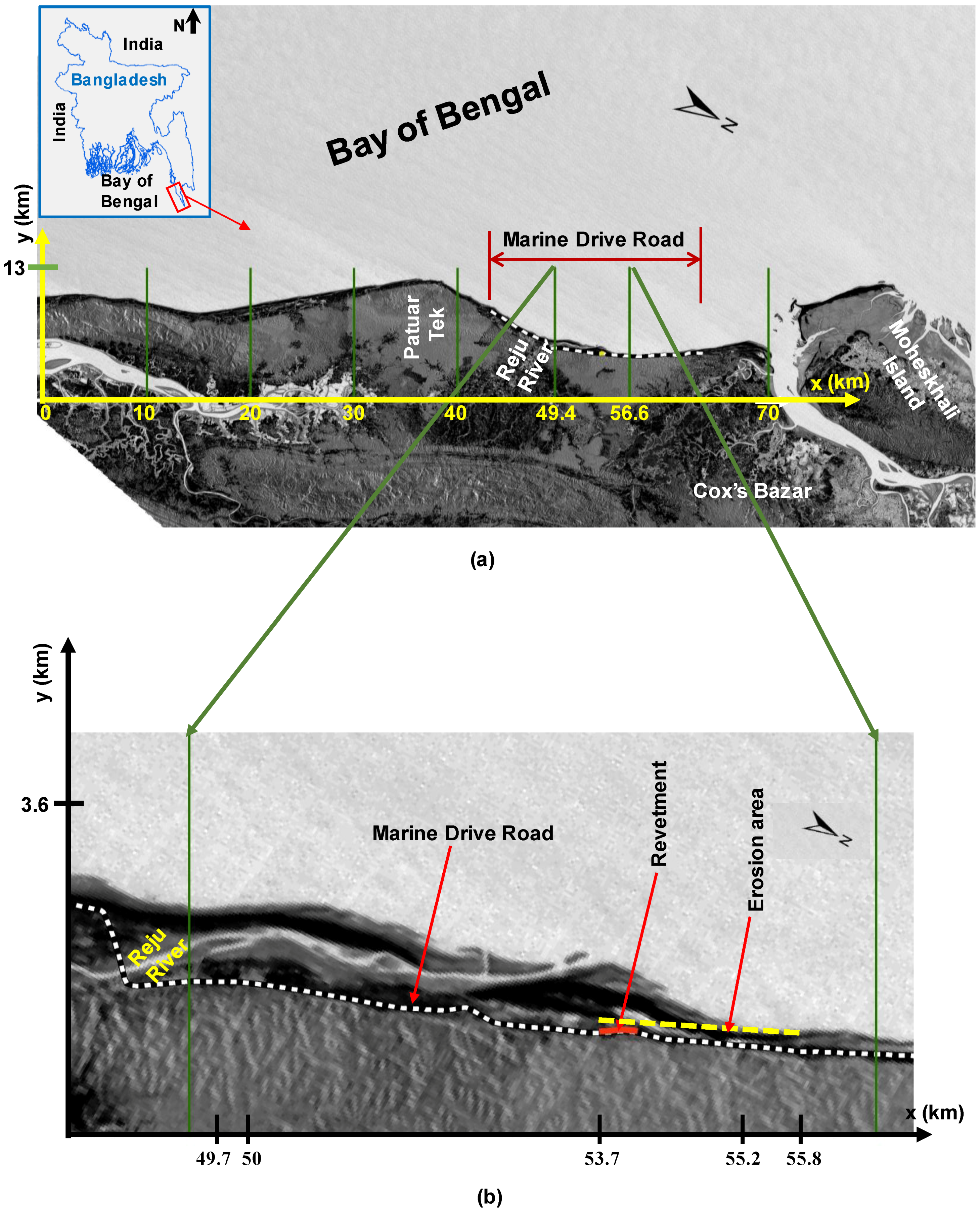
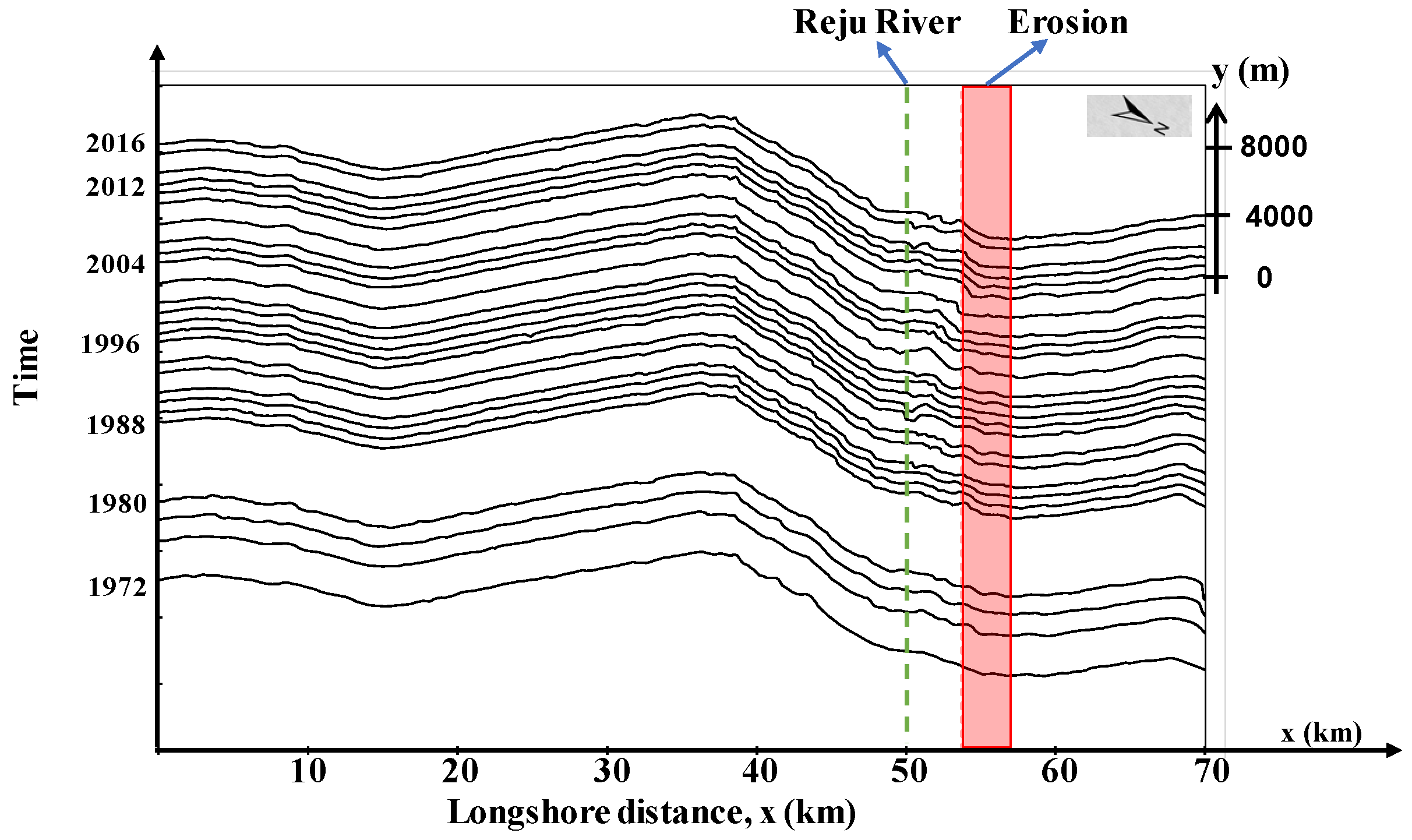
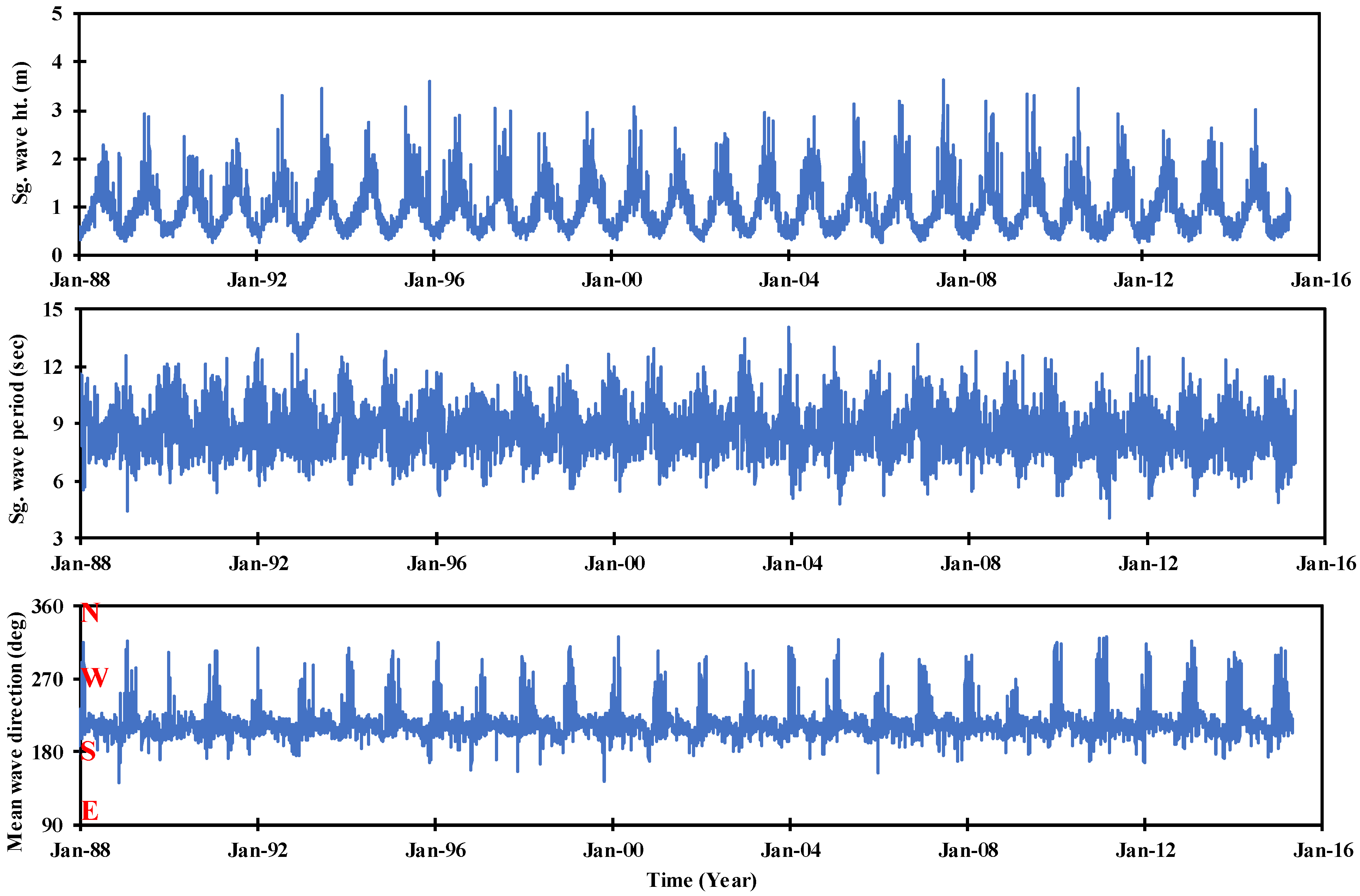
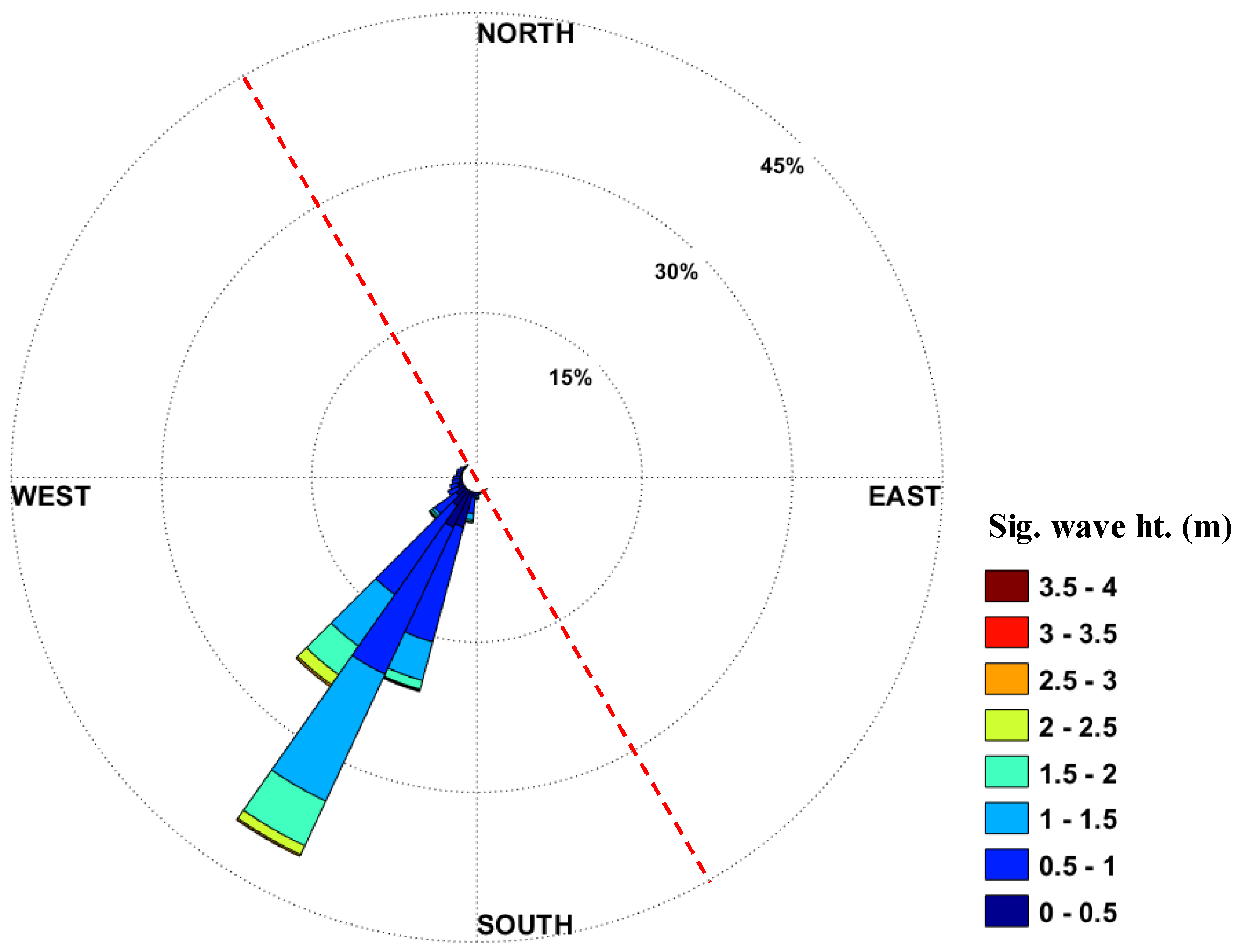
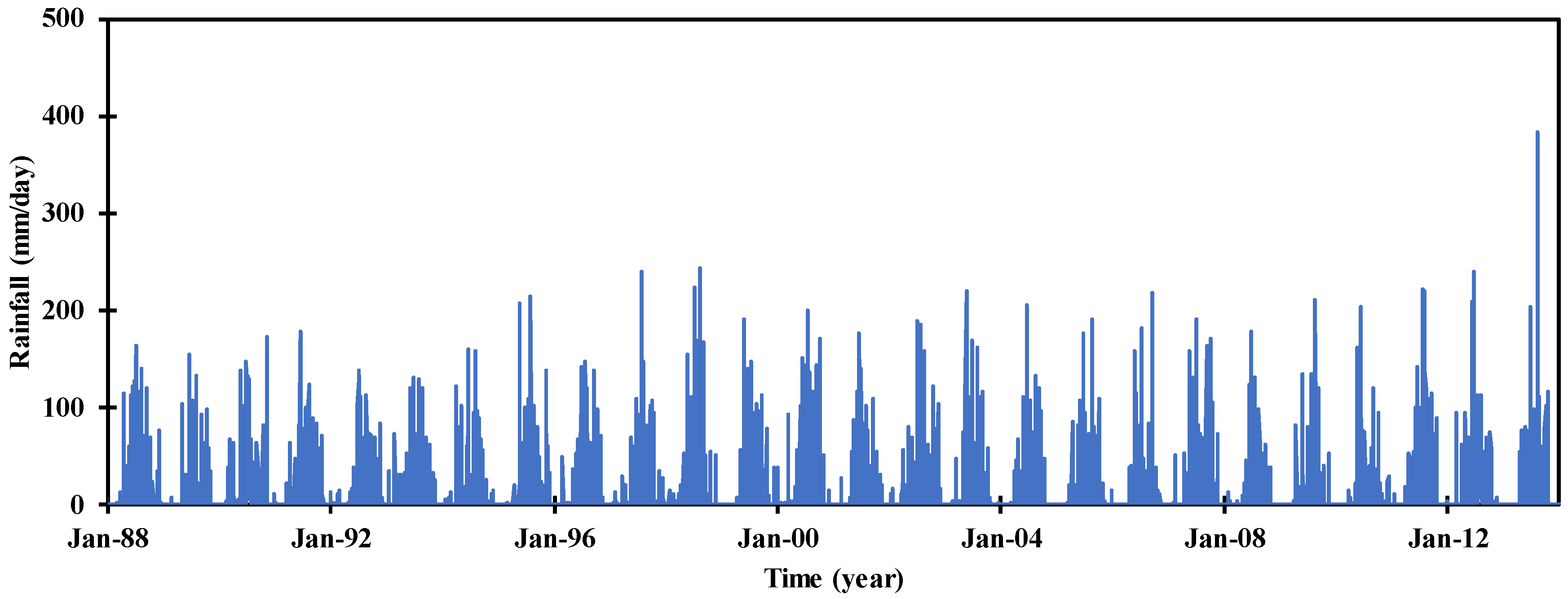

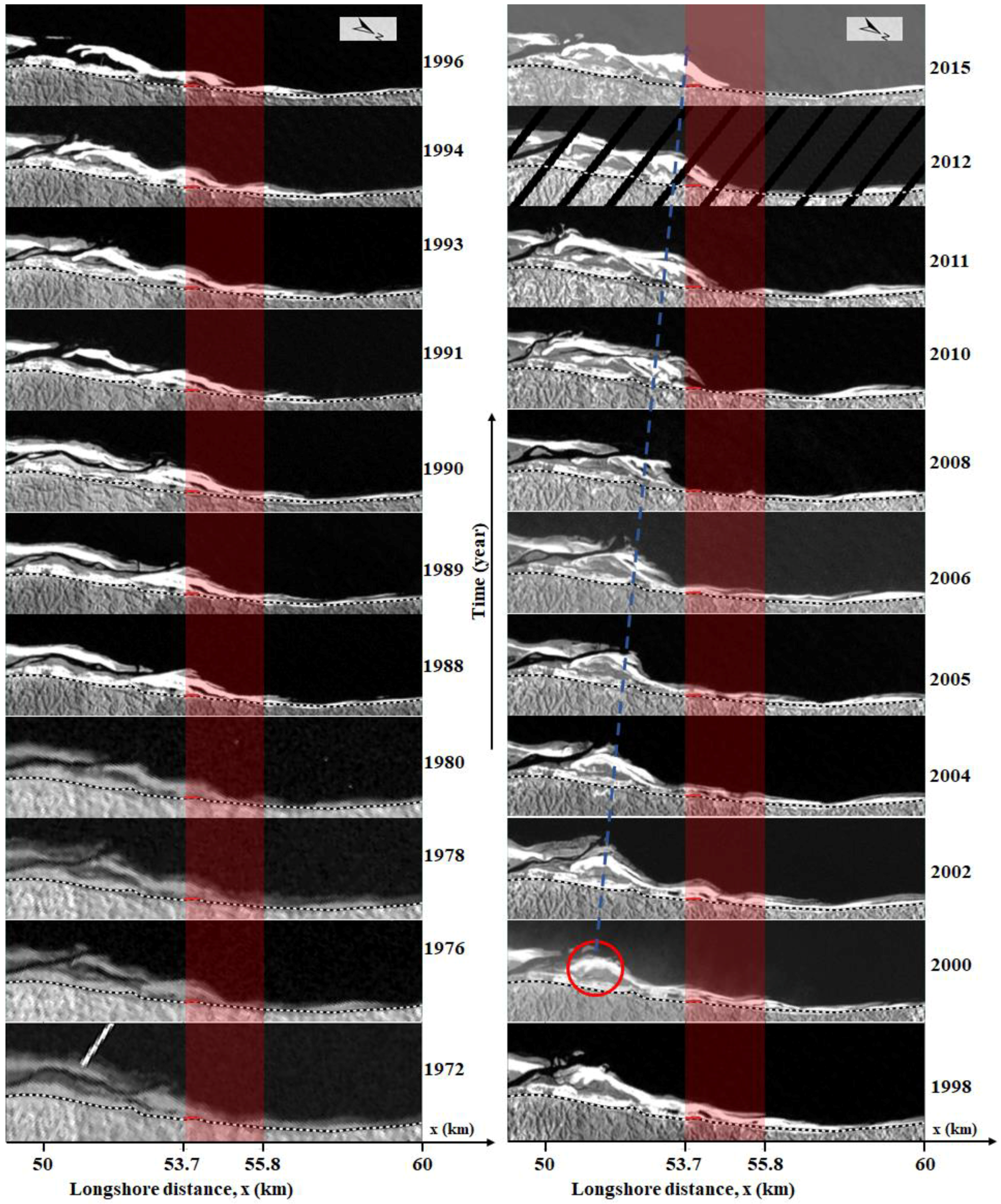
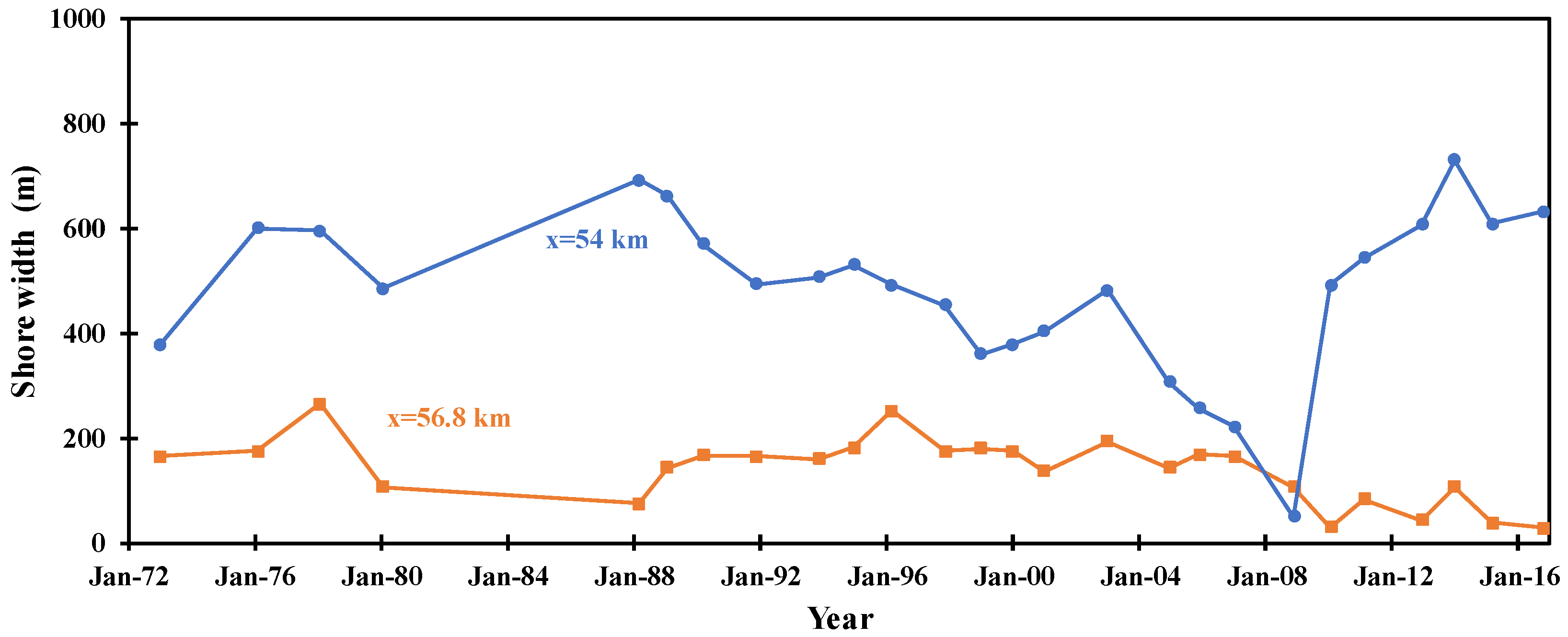

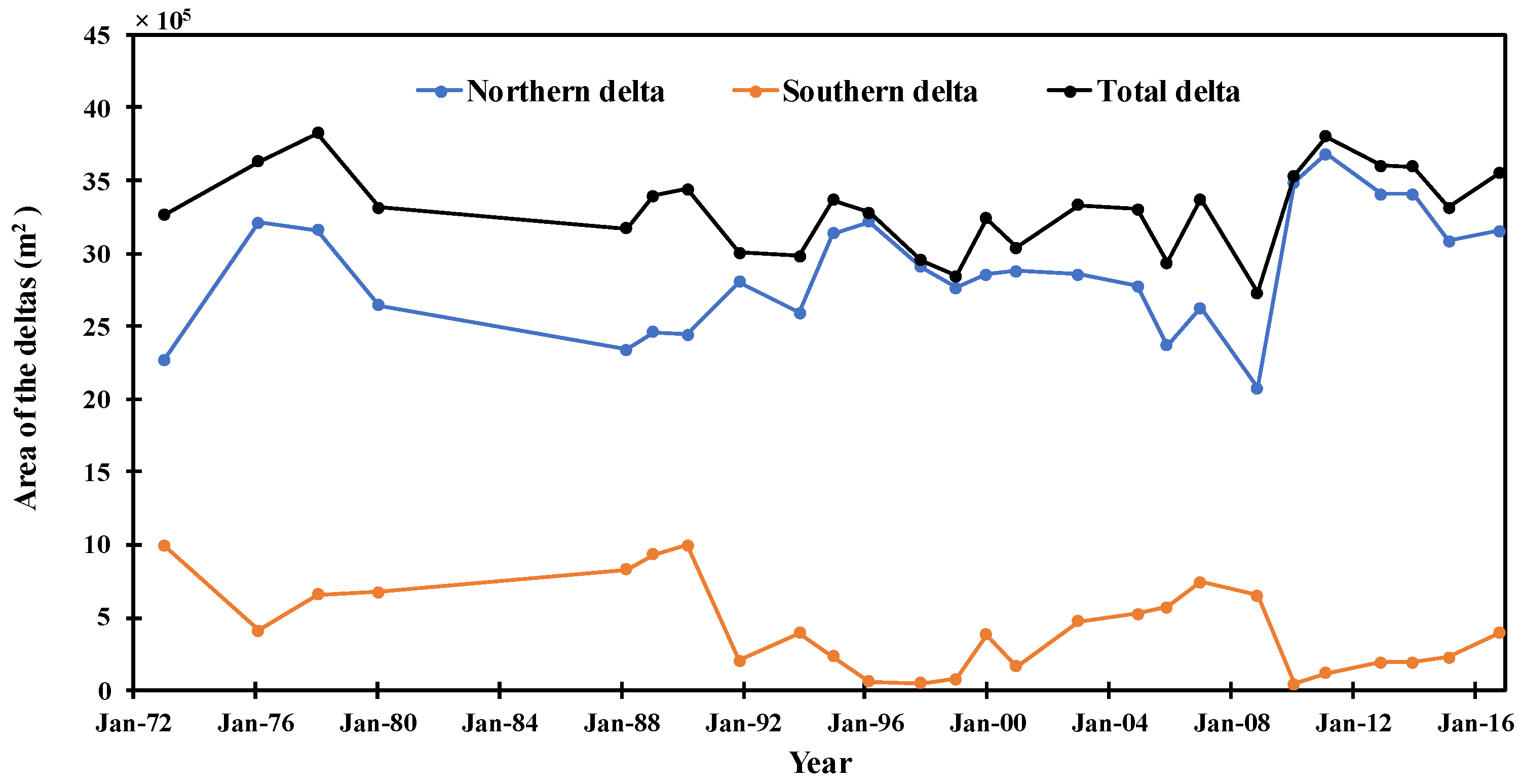
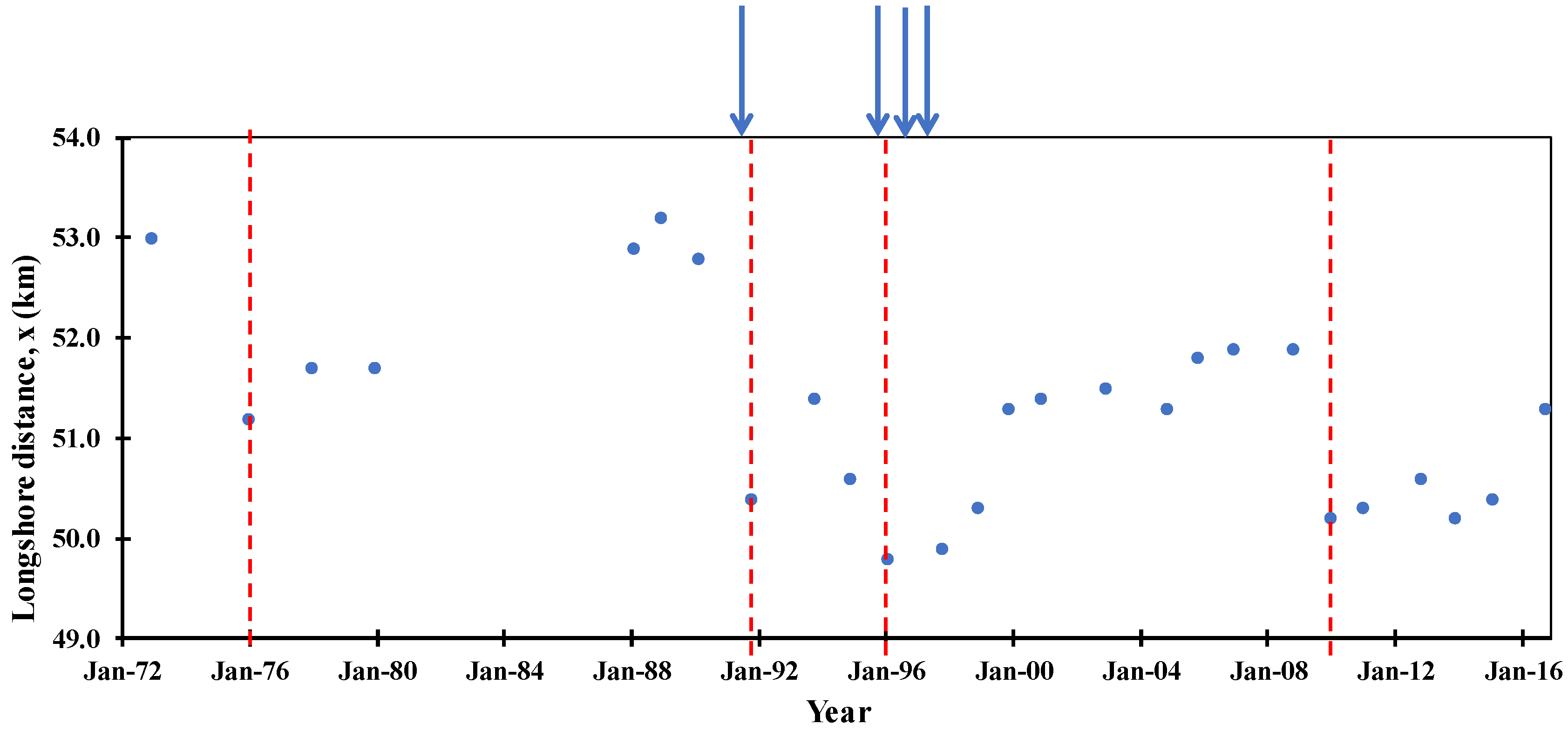
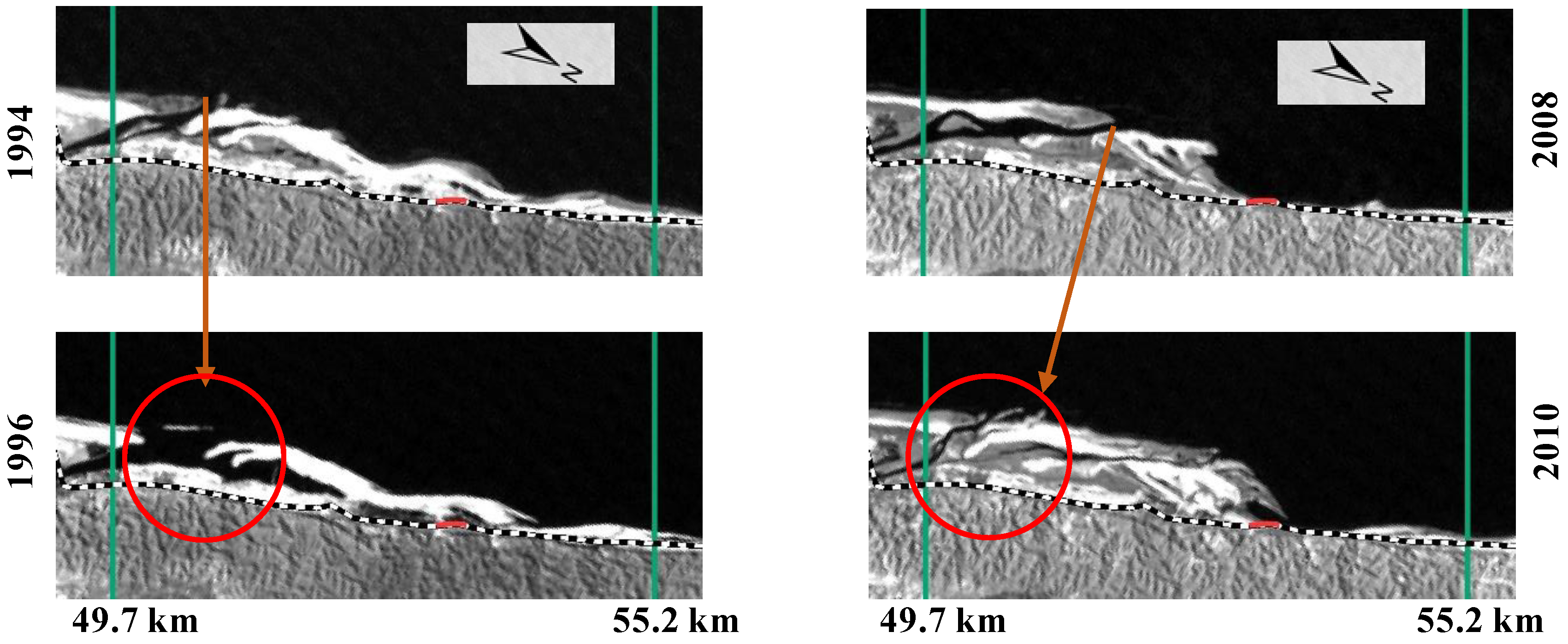

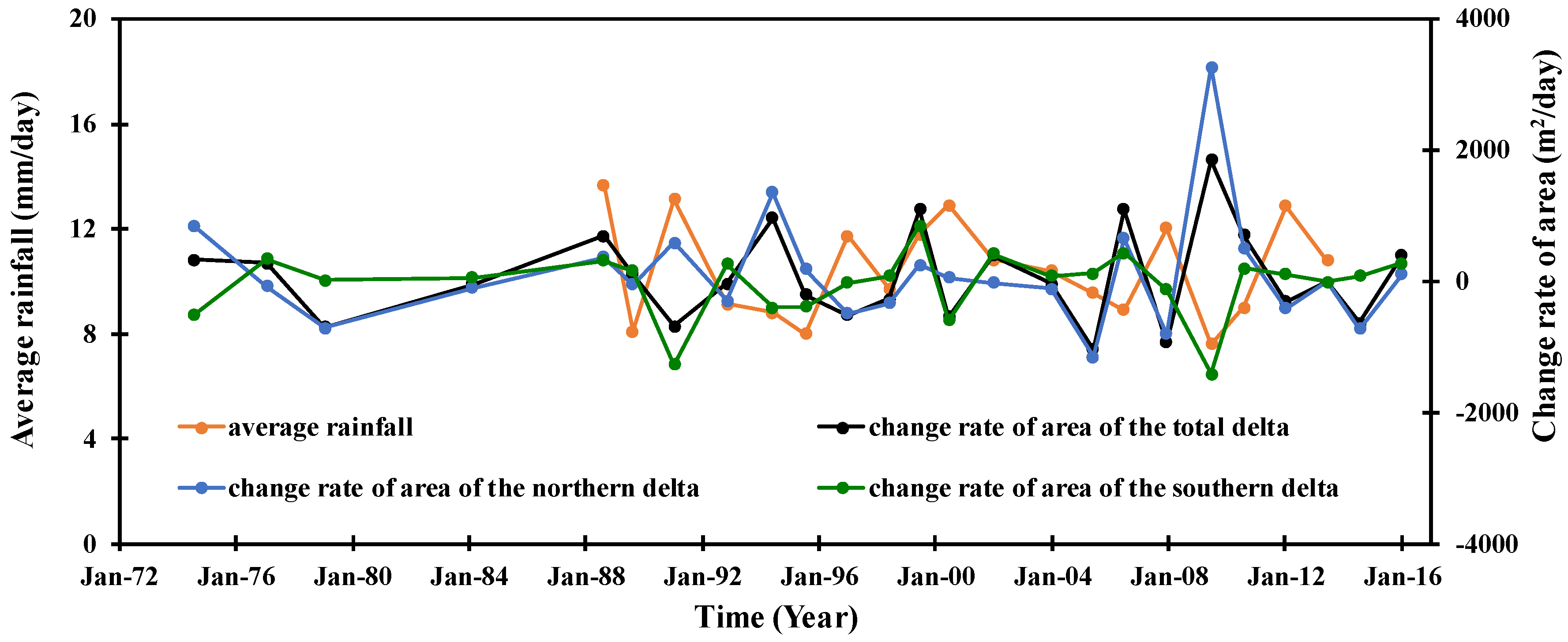
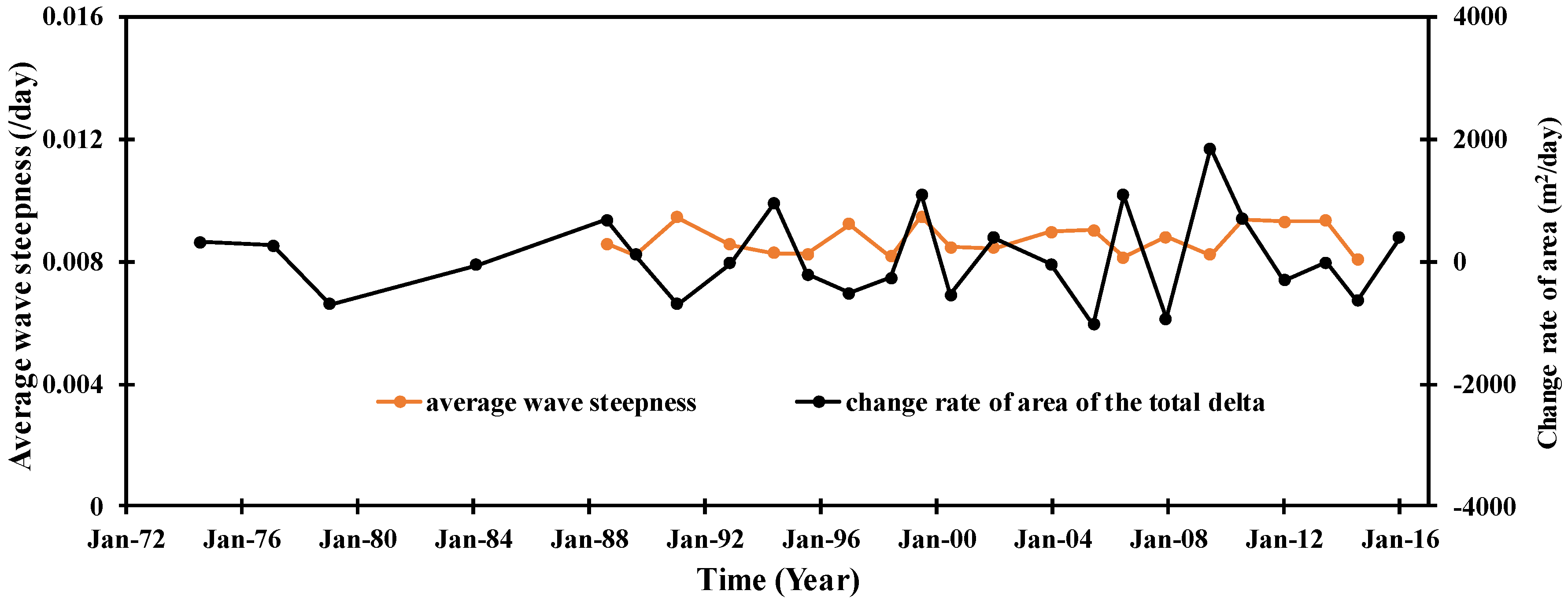


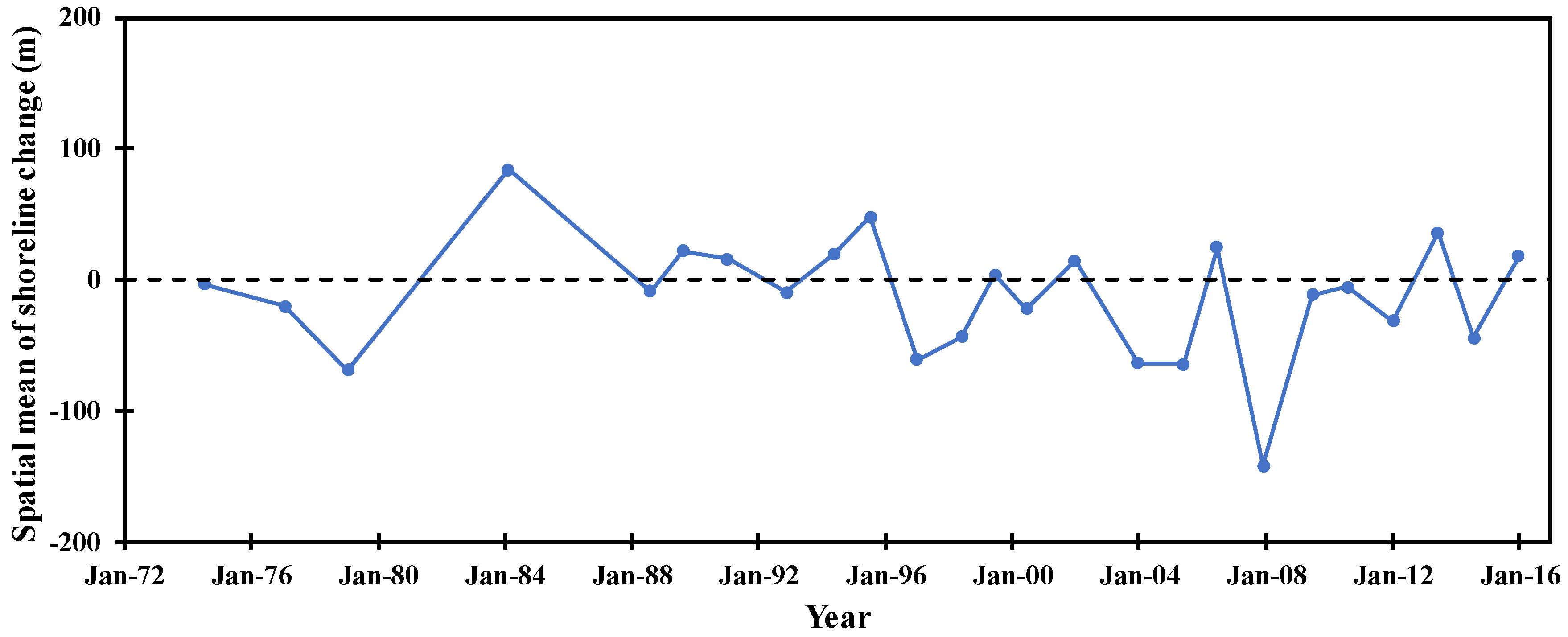

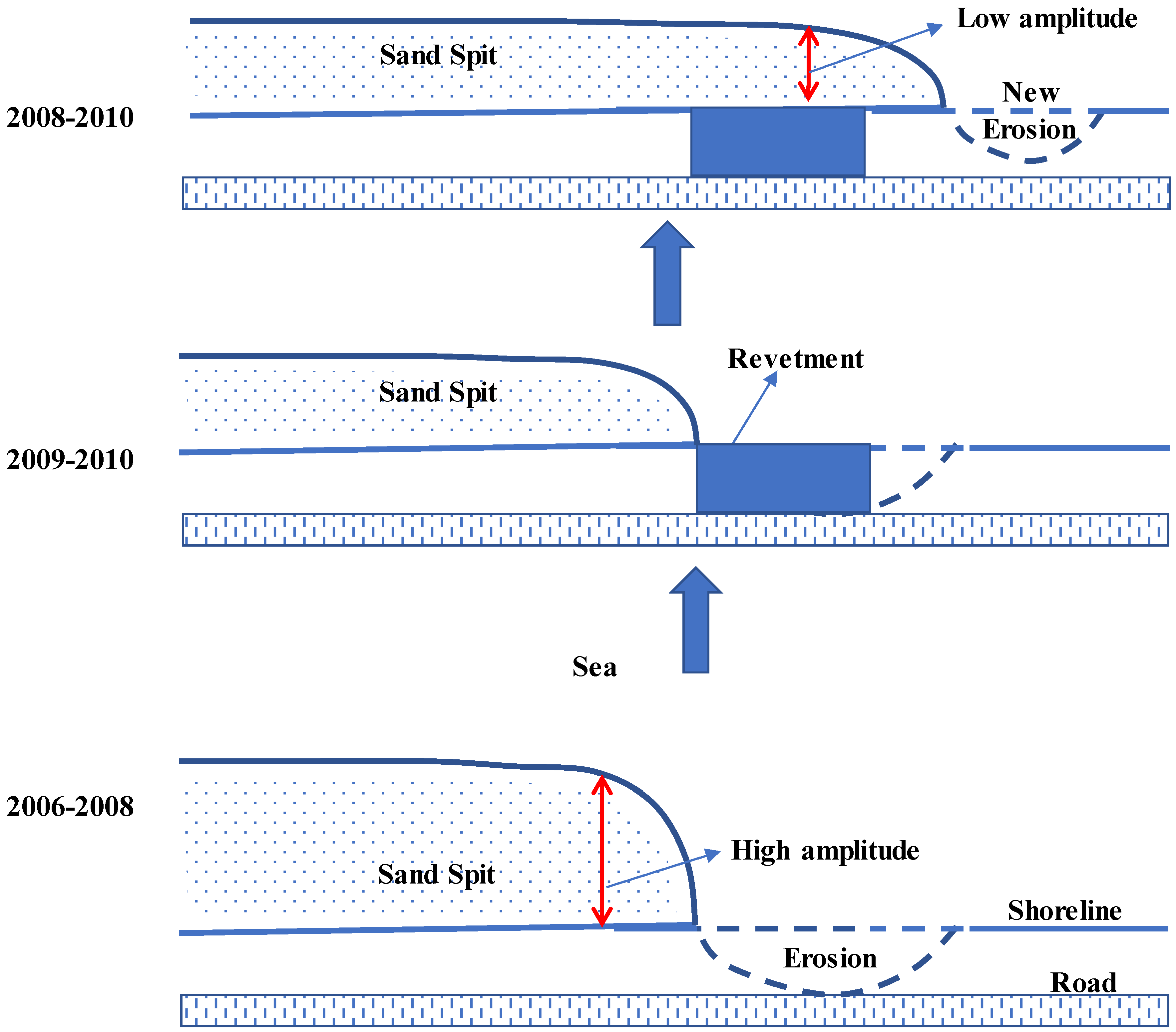
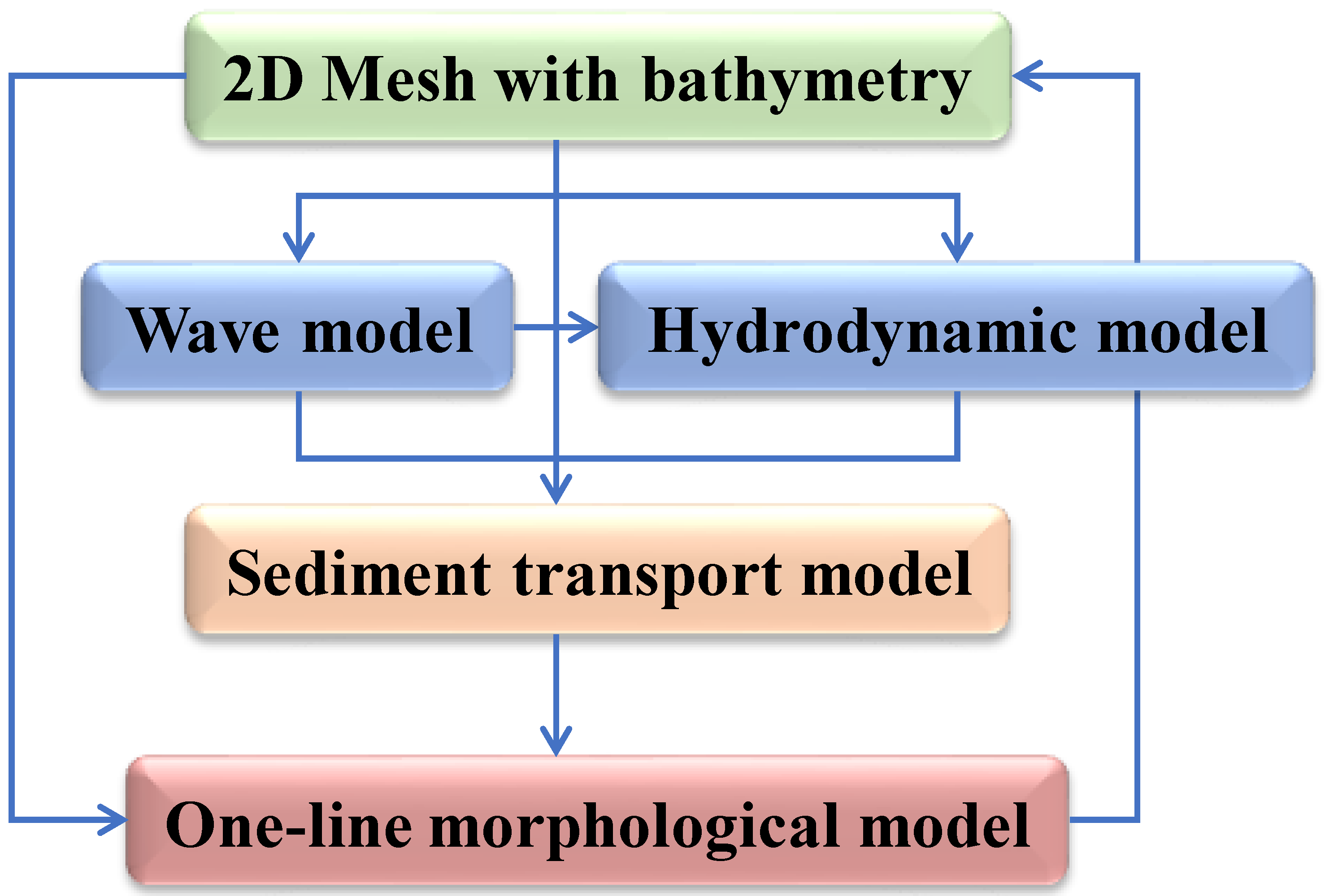
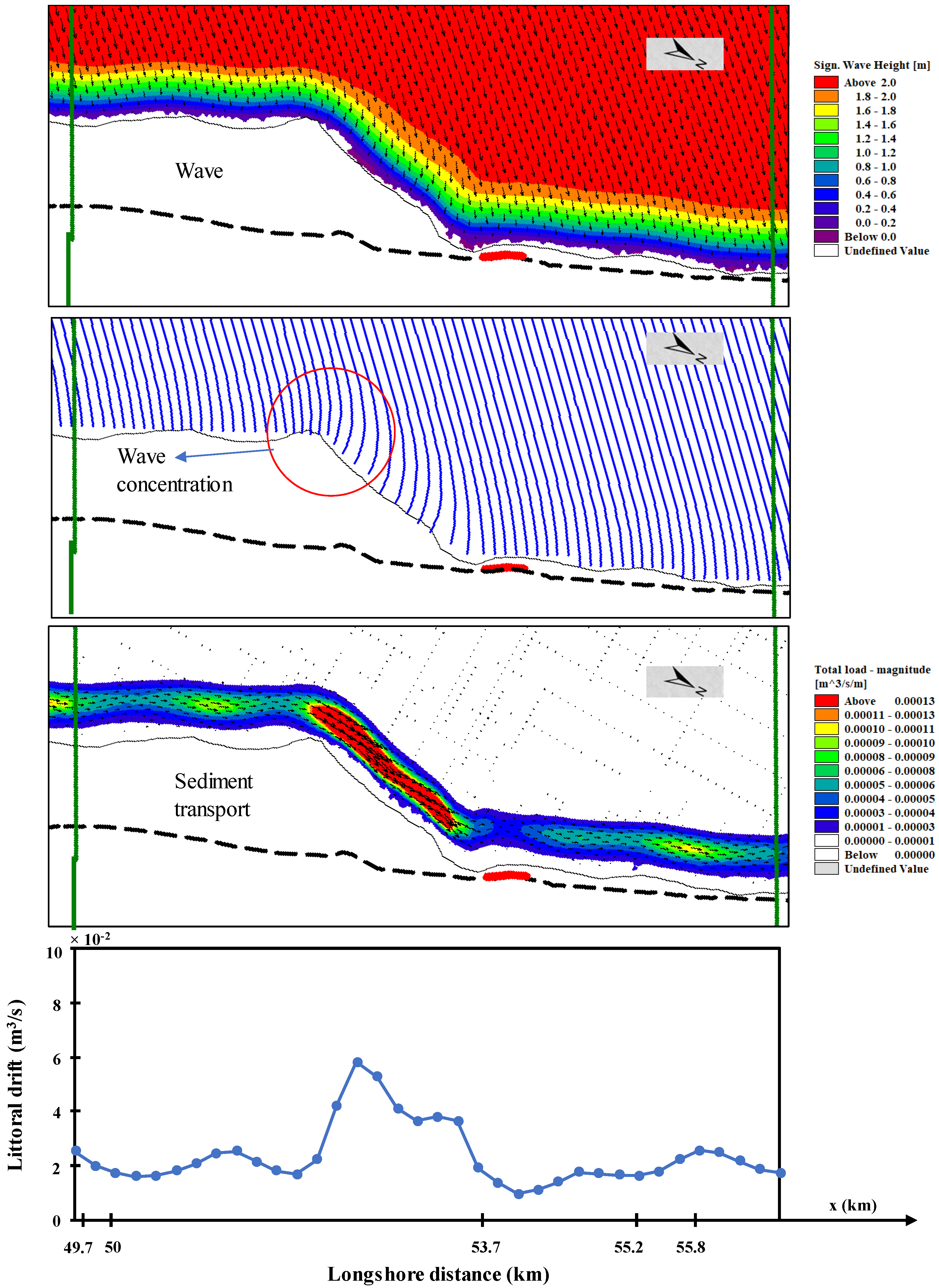
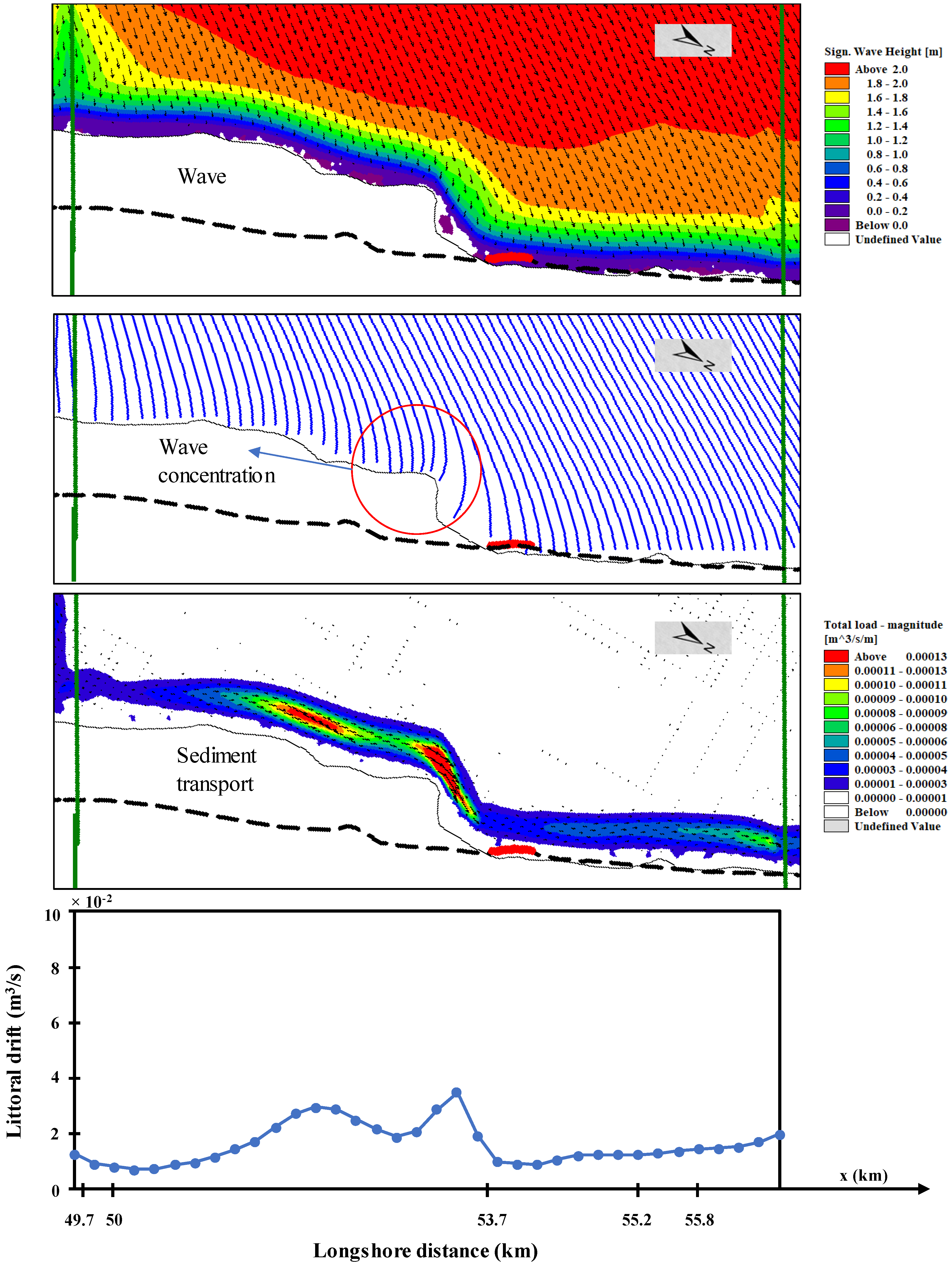
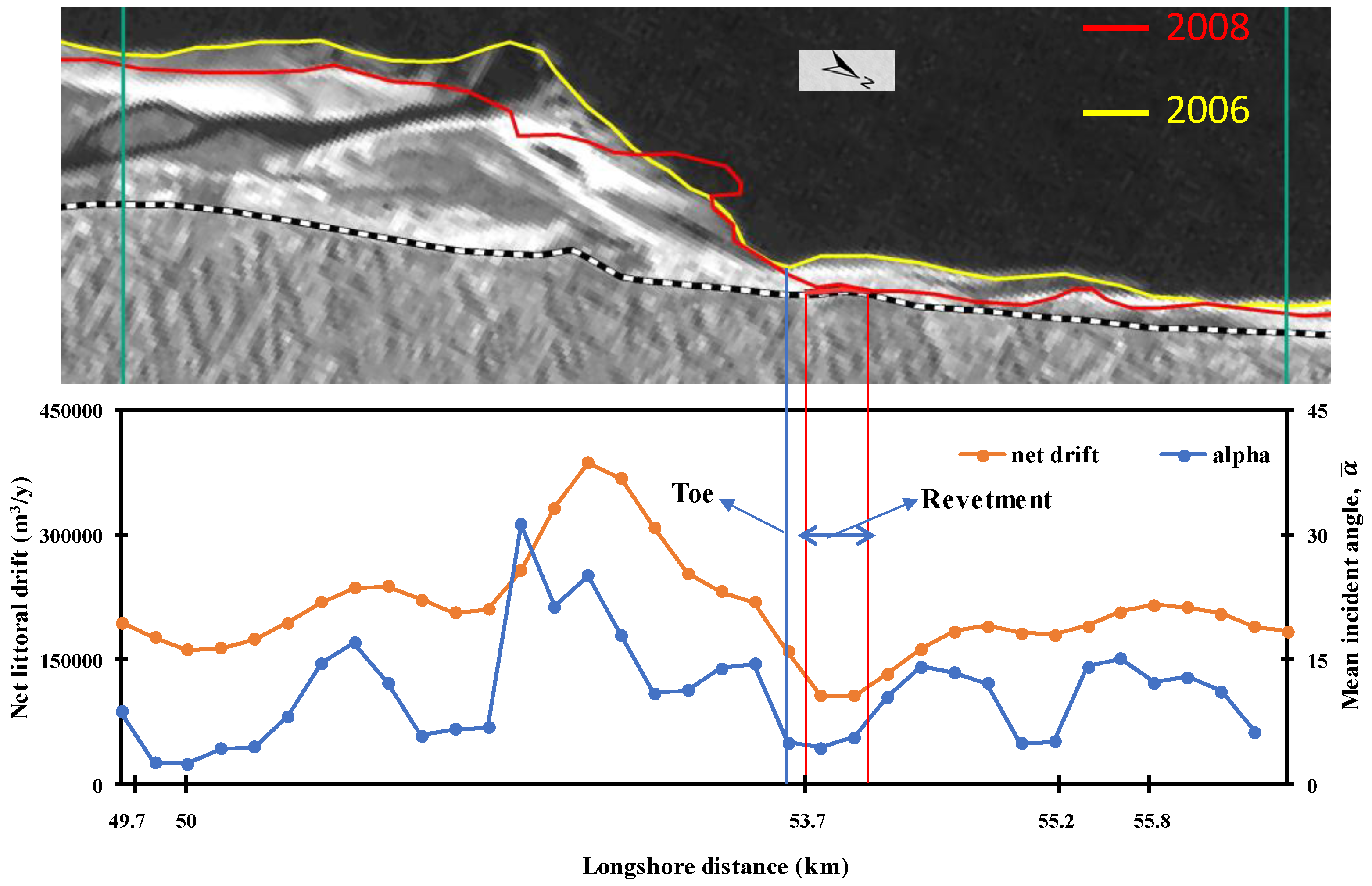

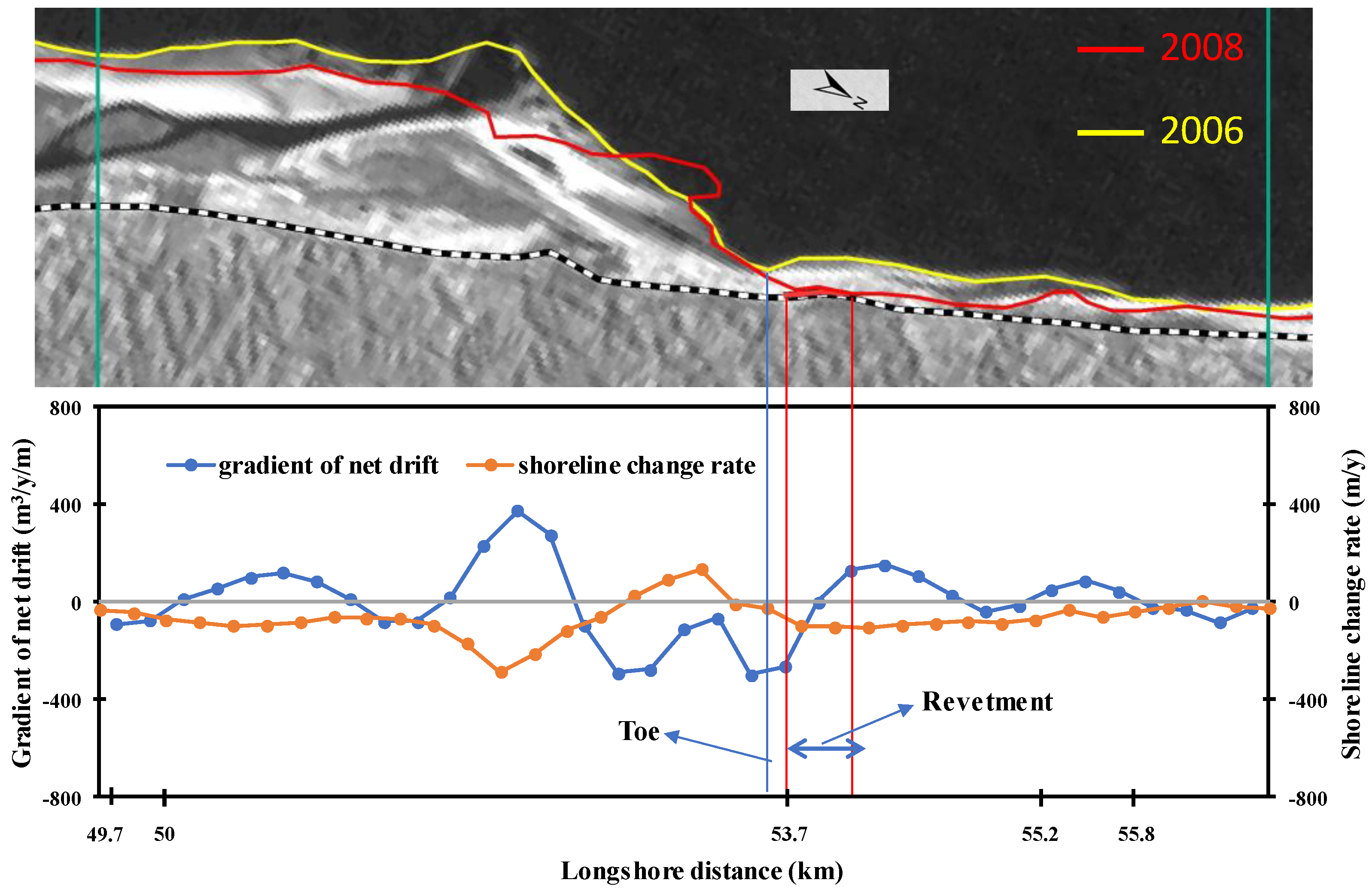
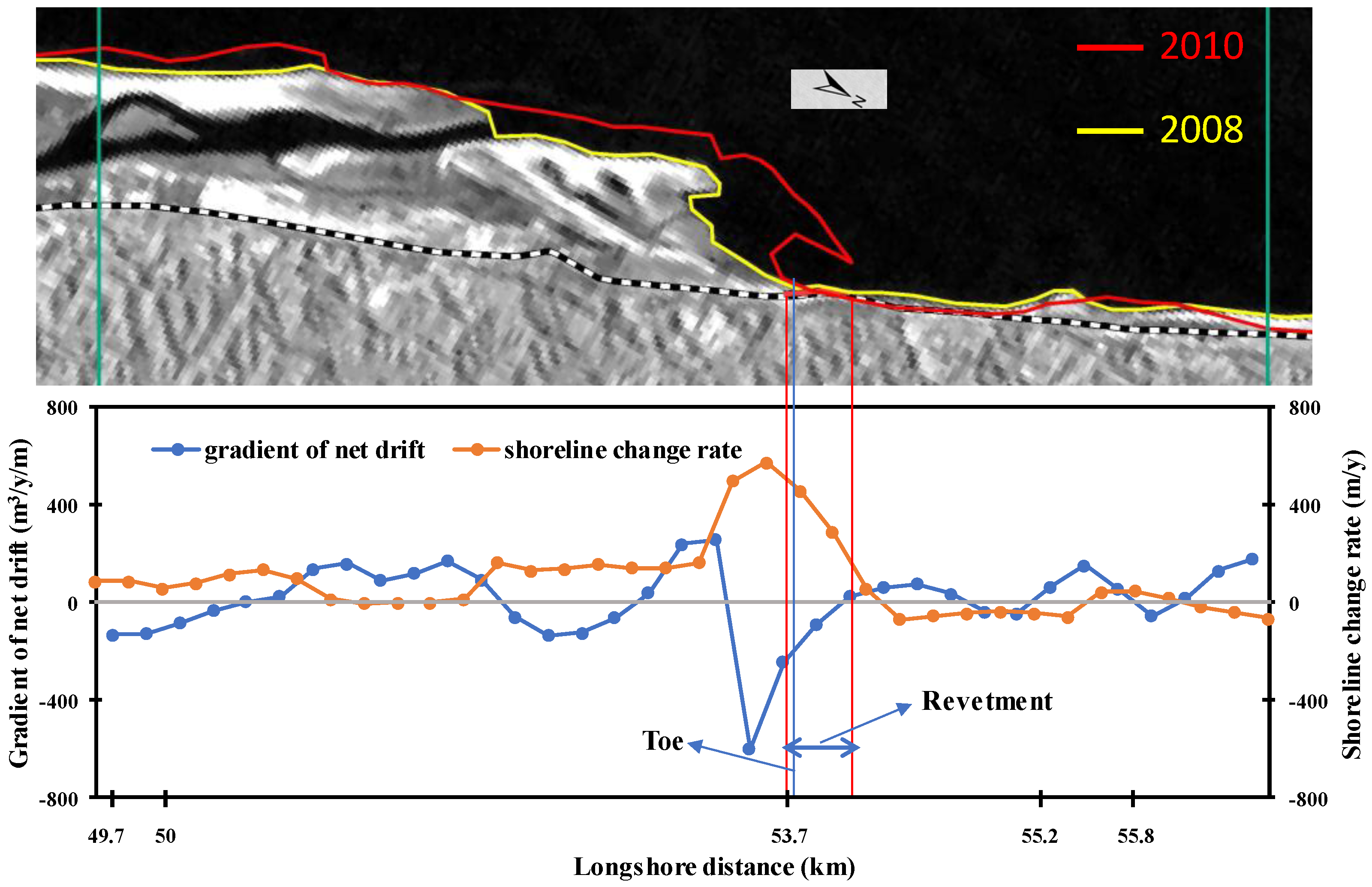
| Serial No. | Satellite | Sensor | Date |
|---|---|---|---|
| 1 | LANDSAT_1 | MSS | 1972/12/27 |
| 2 | LANDSAT_2 | MSS | 1976/01/26 |
| 3 | LANDSAT_2 | MSS | 1978/01/15 |
| 4 | LANDSAT_3 | MSS | 1980/01/14 |
| 5 | LANDSAT_5 | TM | 1988/02/28 |
| 6 | LANDSAT_5 | TM | 1989/01/13 |
| 7 | LANDSAT_5 | TM | 1990/03/05 |
| 8 | LANDSAT_5 | TM | 1991/11/19 |
| 9 | LANDSAT_5 | TM | 1993/11/08 |
| 10 | LANDSAT_5 | TM | 1994/12/13 |
| 11 | LANDSAT_5 | TM | 1996/02/18 |
| 12 | LANDSAT_5 | TM | 1997/11/03 |
| 13 | LANDSAT_5 | TM | 1998/12/24 |
| 14 | LANDSAT_7 | ETM | 1999/12/19 |
| 15 | LANDSAT_7 | ETM | 2000/12/21 |
| 16 | LANDSAT_7 | ETM | 2002/12/27 |
| 17 | LANDSAT_7 | ETM | 2004/12/08 |
| 18 | LANDSAT_7 | ETM | 2005/11/25 |
| 19 | LANDSAT_7 | ETM | 2006/12/30 |
| 20 | LANDSAT_7 | ETM | 2008/11/17 |
| 21 | LANDSAT_7 | ETM | 2010/01/23 |
| 22 | LANDSAT_5 | TM | 2011/02/11 |
| 23 | LANDSAT_7 | ETM | 2012/12/06 |
| 24 | LANDSAT_8 | OLI_TIRS | 2013/12/17 |
| 25 | LANDSAT_8 | OLI_TIRS | 2015/03/01 |
| 26 | LANDSAT_8 | OLI_TIRS | 2016/10/22 |
| Deltas | Position of River Mouth | Rainfall | Wave Steepness |
|---|---|---|---|
| Northern | −0.74 | −0.36 | −0.22 |
| Southern | 0.95 | 0.07 | 0.10 |
| Total | −0.05 | −0.40 | −0.20 |
© 2018 by the authors. Licensee MDPI, Basel, Switzerland. This article is an open access article distributed under the terms and conditions of the Creative Commons Attribution (CC BY) license (http://creativecommons.org/licenses/by/4.0/).
Share and Cite
Mahamud, U.; Takewaka, S. Shoreline Change around a River Delta on the Cox’s Bazar Coast of Bangladesh. J. Mar. Sci. Eng. 2018, 6, 80. https://doi.org/10.3390/jmse6030080
Mahamud U, Takewaka S. Shoreline Change around a River Delta on the Cox’s Bazar Coast of Bangladesh. Journal of Marine Science and Engineering. 2018; 6(3):80. https://doi.org/10.3390/jmse6030080
Chicago/Turabian StyleMahamud, Upal, and Satoshi Takewaka. 2018. "Shoreline Change around a River Delta on the Cox’s Bazar Coast of Bangladesh" Journal of Marine Science and Engineering 6, no. 3: 80. https://doi.org/10.3390/jmse6030080
APA StyleMahamud, U., & Takewaka, S. (2018). Shoreline Change around a River Delta on the Cox’s Bazar Coast of Bangladesh. Journal of Marine Science and Engineering, 6(3), 80. https://doi.org/10.3390/jmse6030080





